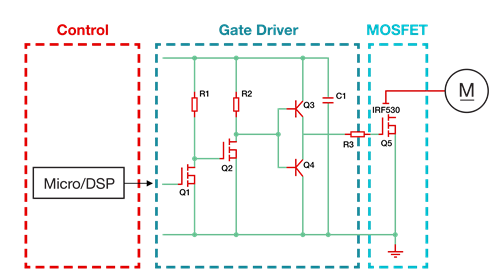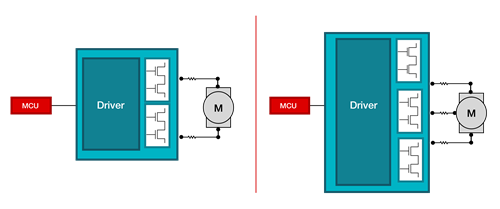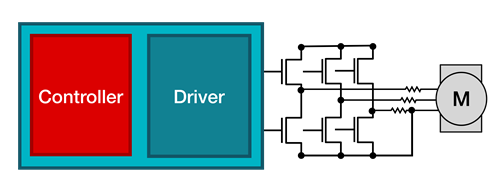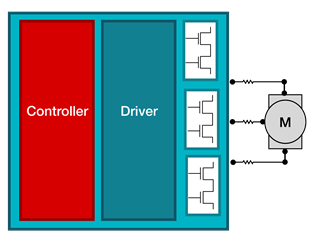SSZTCY3 June 2023 DRV8329 , DRV8962 , MCF8315A , MCT8329A , UCC21732 , UCC27712
This article is part three of our motion control technical article series (part one | part two)
If you’re designing a motor-drive application, you’ve likely traditionally relied on multiple discrete components such as bipolar junction transistors (BJTs) to implement motor control. While this approach is typically less expensive, it can increase overall component count and board space, as well as design time and complexity. Using multiple components can also affect system reliability.
Integration becomes critical as applications become more complex, higher powered and smaller. Integrated solutions can shorten design time and reduce procurement complexity and costs, while ensuring a reliable, efficient motor system
In this article, I’ll compare different motor-control implementations – ranging from discrete to fully integrated options – to help you find the right approach for your design. Table 1 compares the levels of integration in each motor control option.
| Control | Driver | FET | |
|---|---|---|---|
| Discrete BJT | |||
| Gate-driver integrated circuit (IC) | X | ||
| Motor-driver IC | X | X | |
| Integrated control gate-driver IC | X | X | |
| Integrated control, gate driver and field-effect transistor (FET) IC | X | X | X |
Discrete approaches to motor control
Figure 1 depicts a control unit such as microcontroller (MCU) that processes feedback on motor status and sends signals to regulate the motor’s torque, position, and speed. The gate driver amplifies the MCU’s signal to drive the metal-oxide semiconductor field-effect transistor (MOSFET) for the motor.
 Figure 1 Basic motor-control block diagram
Figure 1 Basic motor-control block diagramYou can use BJT totem-pole/push-pull circuits as gate-drive circuitry to drive a single MOSFET, as shown in Figure 2. While cheap and easy to implement, a BJT totem-pole circuit has a high component count and takes up a lot of board space. Plus, you have to replicate this discrete circuit because you need multiple MOSFETs to drive a motor, which multiplies the component count and board space required.
 Figure 2 Implementation of the
gate-driver block with a discrete BJT totem-pole/push-pull circuit
Figure 2 Implementation of the
gate-driver block with a discrete BJT totem-pole/push-pull circuitFirst integrated option: gate-driver ICs
A basic gate-driver IC integrates the functionality of the totem pole into a single package. Recent process technology innovations have made gate-driver ICs as affordable as a discrete-based BJT.
There are several considerations when choosing a gate-driver IC, such as channel count and the voltage and current capabilities best suited for a motor’s power levels, as shown in Figure 3.
Integrated gate-driver ICs include:
- One-channel gate drivers such as TI’s UCC21732 are typically seen in AC motors driving high- and low-side high voltage (>700-V) power switches such as insulated gate bipolar transistors (IGBTs) and silicon carbide (SiC)
- Two-channel half-bridge gate drivers such as the UCC27712 for 100- to 700-V motors to drive IGBTs and MOSFETs
- Four-channel H-bridge drivers and six-channel three-phase motor gate drivers such as the DRV8329. are designed for lower voltage MOSFETs (<60-V) DC motors
As the power levels of motors change, using gate drivers allows you to keep the previous design while only changing the external FETs to accommodate new voltage and current levels.
 Figure 3 Types of gate-driver ICs driving external FETs
Figure 3 Types of gate-driver ICs driving external FETsGate drivers range from basic features, such as undervoltage lockout and interlock protection to prevent cross-conduction, to advanced features, such as smart gate drive for slew-rate control and automatic dead time. Learn more about these gate drivers in the application note, “Understanding Smart Gate Drive.”
External components traditionally set the slew rate: two source and sink resistors to limit the current to the gate of a MOSFET, one diode to individually adjust the rise and fall rates, and one pull-down resistor. Smart gate drive eliminates these components, while offering the flexibility to adjust the slew rate through Serial Peripheral Interface.
Using a six-channel driver with smart gate drive eliminates as many as 24 discrete components, saving board space and bill-of-materials (BOM) count. Other protection and diagnostic features integrated into gate drivers include current sensing, overcurrent and overtemperature protection, fault detection, and even isolation, which further reduces component count.
Second integrated option: A motor-driver IC
A motor-driver IC, which includes a gate driver and integrated FETs, is a good fit for low-power motor systems (<70 W), as shown in Figure 4. Motor-driver ICs have a smaller footprint than gate drivers; integrating the FET power stage simplifies the design schematic and layout. Like gate-driver ICs, motor-driver ICs such as the DRV8962 also integrate protection and diagnostic features.
 Figure 4 H-bridge and three-phase motor
drivers with integrated FETs
Figure 4 H-bridge and three-phase motor
drivers with integrated FETsWhen selecting a motor-drive solution, you must consider the RDS(ON) of the internal FETs, as well as the peak current and root-mean-square current. The power dissipation of the internal FETs also makes it necessary to perform thermal calculations.
Third integrated option: Integrated control gate driver ICs
Unlike the first two options, integrated control gate-driver ICs such as the MCT8329A don’t require an MCU for motor control. These ICs still have gate-driver functionality with protection and diagnostics, while incorporating control algorithms without MCU assistance, as shown in Figure 5.
The implementation of motor commutation algorithms – whether trapezoidal, sinusoidal or field-oriented control – can be complex. Integrated control gate driver ICs provide a code-free solution that handles the commutation algorithm internally, allowing you to reduce your design time and streamline coding, debugging and testing complexity.
 Figure 5 An integrated control
three-phase gate driver
Figure 5 An integrated control
three-phase gate driverIntegrated control gate-driver ICs also provide flexibility when implementing motor commutation with either sensored or sensorless control. A sensored approach allows the use of external Hall-effect sensors to detect the rotor position; these ICs can take the Hall-effect sensor inputs and leverage a motor-control algorithm to drive the motor efficiently and quietly. In contrast, a sensorless implementation removes external Hall-effect sensors to reduce board space and BOM. A sensorless integrated control gate-driver IC involves measuring back-electromotive (back-EMF) force voltages through integrated current sensing and calculates the motor position internally.
Fourth integrated option: Integrated control, gate driver and FET ICs
The final integrated option is often called “full integration,” as shown in Figure 6. An integrated control, gate driver and FET IC such as the MCF8315A takes up the least amount of board space and has the lowest BOM by integrating code-free control functionality, a driver with protection and diagnostic features, and FETs, all within a single chip. Similar to the motor-driver IC option, integrated control, gate driver and FET IC solutions are limited by the capabilities of the internal FETs, so current and thermal calculations are necessary.
 Figure 6 Fully integrated – motor
control plus driver plus FETs
Figure 6 Fully integrated – motor
control plus driver plus FETsConclusion
Not only are there varying levels of ICs with integration to meet your motor’s power-level requirements, but these ICs also can simplify design time, cost and complexity. Integrated devices can also address challenges such as audible noise in home appliances and precision control in factory automation and robotics.